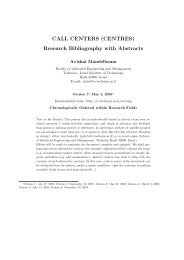Uncertainty in the Demand for Service - Faculty of Industrial ...
Uncertainty in the Demand for Service - Faculty of Industrial ...
Uncertainty in the Demand for Service - Faculty of Industrial ...
You also want an ePaper? Increase the reach of your titles
YUMPU automatically turns print PDFs into web optimized ePapers that Google loves.
4.2 Future Work<br />
• Updat<strong>in</strong>g <strong>the</strong> exist<strong>in</strong>g simulation s<strong>of</strong>tware - our first step will be generaliz<strong>in</strong>g <strong>the</strong><br />
simulation code developed by Feldman [4] with <strong>the</strong> features <strong>of</strong> random arrival rate. We<br />
will first check <strong>the</strong> results <strong>of</strong> <strong>the</strong> basic stationary Erlang-A model, and after that, we will<br />
consider <strong>the</strong> expansion <strong>of</strong> <strong>the</strong> algorithm to <strong>the</strong> time vary<strong>in</strong>g Erlang-A model <strong>in</strong> <strong>the</strong> random<br />
arrival rate case.<br />
• Validate and understand <strong>the</strong>oretically Figure 4 - this step entails two th<strong>in</strong>gs :<br />
1. Establish <strong>the</strong> square-root staff<strong>in</strong>g rule by compar<strong>in</strong>g simulation results <strong>for</strong> random<br />
arrival rate with <strong>the</strong>oretical results as <strong>in</strong> Figure 4, which are based on <strong>the</strong> square-root<br />
staff<strong>in</strong>g rule (3).<br />
2. Understand <strong>the</strong>oretically <strong>the</strong> functions shape. Important and <strong>in</strong>terest<strong>in</strong>g th<strong>in</strong>gs to<br />
understand from <strong>the</strong> graphs are <strong>the</strong> <strong>in</strong>tersection po<strong>in</strong>ts <strong>of</strong> each function with <strong>the</strong> Y<br />
axis (<strong>the</strong> case <strong>of</strong> β = 0, namely N = R), with <strong>the</strong> Garnett function and with <strong>the</strong> o<strong>the</strong>r<br />
functions. In additional, we would like to understand <strong>the</strong> changes <strong>of</strong> <strong>the</strong> functions<br />
from convexity to concavity, and <strong>the</strong> values <strong>of</strong> β <strong>for</strong> which α is stabilized.<br />
• Arrival rate as a cont<strong>in</strong>uous random variable - we shall generalize our results to<br />
arrival rates with densities. For example, we may let <strong>the</strong> prior distribution <strong>of</strong> Λ be Gamma<br />
which is <strong>the</strong> conjugate distribution <strong>of</strong> <strong>the</strong> Poisson distribution. In o<strong>the</strong>r words, if we<br />
sample Λ we get a posterior distribution which is ano<strong>the</strong>r Gamma distribution with a<br />
simple change <strong>of</strong> <strong>the</strong> parameters. Ano<strong>the</strong>r cont<strong>in</strong>uous distribution which may be taken<br />
<strong>in</strong>to consideration is <strong>the</strong> Normal distribution, which is a natural choice when one has no<br />
detailed analysis <strong>of</strong> <strong>the</strong> distribution <strong>of</strong> Λ. In do<strong>in</strong>g so, we should assume that <strong>the</strong> standard<br />
deviation <strong>of</strong> Λ is relatively small compared to its mean, so that negative values would occur<br />
with only a negligible probability. However, <strong>the</strong> complexity <strong>of</strong> work<strong>in</strong>g with <strong>the</strong> normal<br />
distribution must be taken <strong>in</strong>to consideration.<br />
• Theoretical results - motivated by <strong>the</strong> work <strong>of</strong> Half<strong>in</strong> - Whitt [7] and Garnett [5], <strong>the</strong><br />
next step will <strong>in</strong>volve develop<strong>in</strong>g a parallel <strong>the</strong>orem to those which are described <strong>in</strong> Section<br />
2, <strong>in</strong> <strong>the</strong> case where <strong>the</strong> arrival rate is a random variable. For <strong>the</strong> M/G/N model (Poisson<br />
arrivals, general service time distribution and N servers) <strong>the</strong>re is, currently, no Half<strong>in</strong>-<br />
Whitt-like <strong>the</strong>orem. Hence, <strong>in</strong>stead <strong>of</strong> ma<strong>the</strong>matical analysis we shall use simulation, which<br />
is applied to this model, <strong>in</strong> order to obta<strong>in</strong> similar results to <strong>the</strong> ones <strong>of</strong> Half<strong>in</strong>-Whitt and<br />
Garnett. Moreover, we shall consider approximations <strong>of</strong> per<strong>for</strong>mance measures that yield<br />
<strong>in</strong>sight as to <strong>the</strong>ir dependence on <strong>the</strong> model’s parameters. Part <strong>of</strong> <strong>the</strong>se approximations are<br />
diffusion approximations <strong>for</strong> stochastic processes, such as <strong>the</strong> process Q = {Q(t), t ≥ 0},<br />
where Q(t) is <strong>the</strong> number <strong>of</strong> customer present <strong>in</strong> <strong>the</strong> system at time t. This k<strong>in</strong>d <strong>of</strong><br />
approximation enables one to analyze <strong>the</strong> processes beyond steady-state.<br />
• Consider<strong>in</strong>g o<strong>the</strong>r per<strong>for</strong>mance measures - we shall try to determ<strong>in</strong>e staff<strong>in</strong>g levels<br />
that will ensure time-stability <strong>of</strong> per<strong>for</strong>mance measures o<strong>the</strong>r than <strong>the</strong> delay probability,<br />
<strong>for</strong> example <strong>the</strong> expected wait<strong>in</strong>g time and <strong>the</strong> probability <strong>of</strong> abandonment.<br />
• Optimization problems - we shall try to f<strong>in</strong>d staff<strong>in</strong>g rules that, when applied, provide<br />
m<strong>in</strong>imum costs or maximum pr<strong>of</strong>it.<br />
15
















